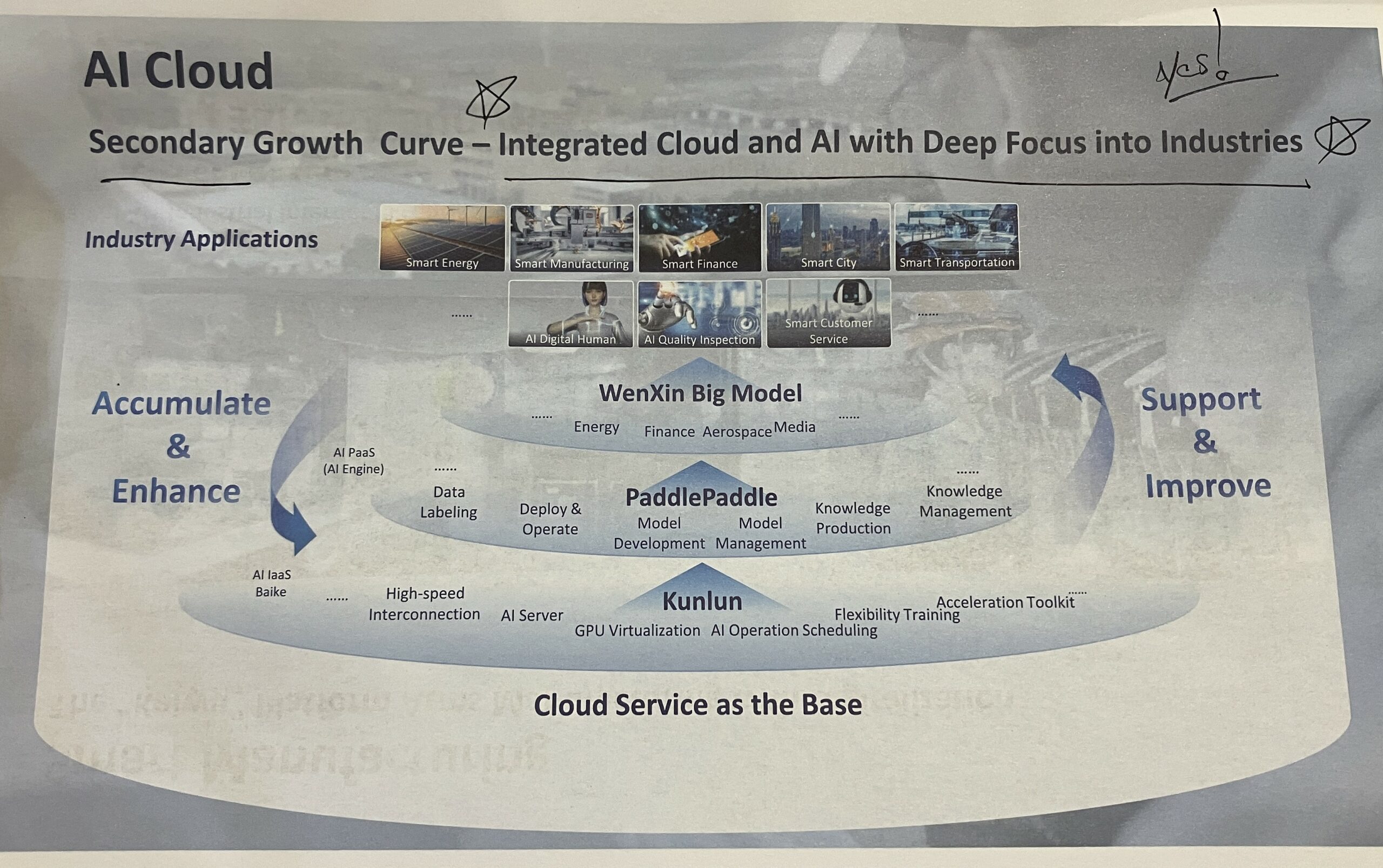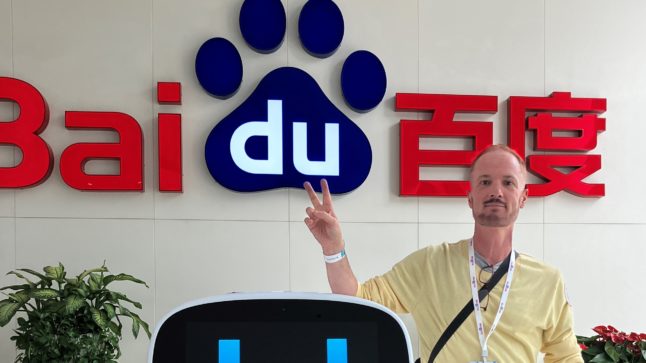In Part 1, I went through the strategy basics for Baidu search. And that was really to tee up Baidu’s big move into AI Cloud.
And I really like Baidu’s AI Cloud Strategy. I think it is really smart.
Plus, I’ve sort of been ranting for 5 years about why Baidu should focus on search and AI-differentiated cloud services. Both have great and proven business models. And Baidu is well positioned to win in both (less so in areas like food delivery and content creation).
Here the podcast I did on this. These articles are an expansion of this.
Baidu now has 3 business units.
- Mobile ecosystem
- AI cloud
- Autonomous driving and other stuff.

In this article, I want to go through the basics of Baidu’s AI tech stack and ERNIE, which is the foundation for their AI Cloud service.
Baidu Has Been Building Its AI Capabilities for +10 Years
Take a look at some of Baidu’s AI history.
2005:
- Launch of Baidu Maps. This will turn out to be important for autonomous driving and real-world AI.
2010:
- Launch of iQIYI. They are doing some really interesting stuff in generative AI right now.
2013:
- Launch Baidu deep learning lab.
- Opened Shanxi cloud computing center.
- Prototyped their first autonomous vehicle.
2015:
- Launch of DuerOS. This will turn into their operating system for autonomous vehicles.
2016:
- Launch of robotaxis and autonomous buses. Initially by retrofitting existing cars.
2017:
- Launch of PaddlePaddle, their opensource deep learning framework. Very important. This is now used by +5m developers.
- Launch of Apollo, their open-source autonomous vehicle platform. The goal is to lower threshold for other companies to do autonomous. Not to build cars itself. This has grown to 210 partners and +80,000 developers.
2018:
- Released their first Kunlun AI semiconductors for training and inference. 19 nm chips.
- Released Cloud Rack 2.0 for centralizing power and computing. Also, X-Man 4.0 server with 4 GPUs and accelerated K100.
2019:
- Launch of ERNIE, their suite of open-source foundation models.
- Deployment of first robotaxis.
So, we can see a full AI tech stack being developed over a decade. All the way from chips to services. And they released their first foundation models years before everyone was talking about GPT.
They are already on their second generation of self-developed AI chips.

Here is the important graphic for Baidu’s AI Cloud. This is the end-to-end tech stack and feedback loop in one slide.

Here’s how Baidu describes this. I’ve added the bold.
“Baidu’s unique four-layer technology stack is comprised of chips, frameworks, models, and applications, which forms an efficient feedback loop to help models continuously optimize and iterate.”
That is really important. And I’ll go through this in the next article.
But the engine of this is their growing suite of open-source foundation models, called ERNIE.
An Introduction to ERNIE (i.e., Wenxin)
Here’s how Baidu describes ERNIE. I’ve added the bold:
“ERNIE refers to the ERNIE Foundation Model, an industry-level knowledge enhancement model developed by Baidu. It utilizes deep learning to integrate learning from massive amounts of data and knowledge, resulting in more efficient and effective learning with strong interpretability.”
This is really precise language. It is worth reading that again. Note what I have bolded.
They are building an “industry-level knowledge enhancement model”. That is a specific type of AI architecture. Closely tied to industry use cases.
They are focused on efficiency and “effective learning” with “strong interpretability.
Their description:
“The ERNIE Foundation Model Family consists of a three-layer model technology system:
- Foundation models for natural language processing, vision, and cross-modality.
- Task models for dialog, cross-language, search, and information extraction.
- Industry models for fields including energy and power, finance, aerospace, media, film and television, automotive, city management, gas, insurance, electronics manufacturing, and social sciences. These models have played a crucial role in promoting the intelligent transformation and upgrading of industries.”
Again, we see a strong focus on driving their AI capabilities to useable industry models.
Here’s the summary.

“Baidu also provides large language models of multiple sizes, such as ERNIE Turbo, ERNIE Speed, ERNIE Tiny, etc. These models can strike a balance between model effect and efficiency, better meeting the needs of various customers and scenarios.”
That is a fantastic summary of what they have been building. And they are way down the path in terms of their thinking and strategy for market adoption. Note the following points:
- The purpose is “industry-level knowledge enhancement”. They are going for the intelligent transformation and upgrading of entire industries. As of November 2022, Baidu has released 11 industry models based on the ERNIE Foundation Model.
- The KPIs are “more efficient and effective learning with strong interpretability”. They state that as of the end of 2023, the “inference cost of ERNIE 3.5 is only about 1% of the March 2023 version. For enterprises and developers, developing native applications and secondary development based on ERNIE can reduce inference costs and improve training efficiency.”
- The goal is an “efficient feedback loop to help models continuously optimize and iterate.”
And in October 2023, they released ERNIE 4.0, which they proclaimed had “significant upgrades in understanding, generation, reasoning, and memory capabilities, achieving performance comparable to GPT-4.”
Note how they break down intelligence in to four specific categories. And CEO Robin Li showed examples of ERNIE 4.0’s capabilities in these four categories. He did this live at the event in October.
- He tested its understanding by asking about public housing loan policies.
- He tested its generative skills by producing advertising posters, copy and videos.
- He tested its reasoning skills with math problem.
- He tested its memory skills by having it write a martial arts novel.
Which brings me to ERNIE Bot, the LLM (think ChatGPT) being built on top of ERNIE.
An Intro to ERNIE Bot (i.e., Wenxin Yiyan)
Baidu says ERNIE Bot “possesses the ability to engage in conversations with individuals, provide answers to questions, assist in content creation, and facilitate efficient access to information, knowledge, and inspiration.”
Here is the history:
- ERNIE Bot’s testing phase began on March 16, 2023.
- In August 2023, ERNIE Bot introduced five official plugins.
- It was opened to the public on August 31, 2023.
- Within 12 hours, the ERNIE Bot app became the top spot on the Apple Store’s list for free apps.
- In December 2023, Baidu launched the ERNIE Bot plugin store, which “provid(es) a wide range of services covering use cases including office productivity, multimodal content understanding and generation, and professional information query.”
An as of December 2023, the number of ERNIE Bot users had reached 100 million. Baidu says it now covers 4,300 scenarios and has 2,492 apps.
***
Another Baidu AI capability to closely follow is PaddlePaddle.
An Intro to PaddlePaddle
As mentioned, Baidu says it has a “unique four-layer technology stack is comprised of chips, frameworks, models, and applications, which forms an efficient feedback loop to help models continuously optimize and iterate.”
That “frameworks level they are talking is a mostly PaddlePaddle.
Baidu describes it as “the first open-source, feature-rich, industry-level deep learning platform in China, developed independently by Baidu”. Basically, it’s their deep learning platform for computer scientists to build with. It’s a competitor to Google’s TensorFlow and Facebook’s Torch toolkit.
Baidu made the decision to open source PaddlePaddle back in 2016. A primary goal has been to make it really easy to use. A “simple on-ramp to deep learning”. So open source. Easy to get started. And requiring less code.
In 2016, then head of PaddlePaddle development Xu Wei, told the Verge that a “machine translation program written with Baidu’s software needs only a quarter of the amount of code demanded by other deep learning tools…”PaddlePaddle provides a simple on-ramp to deep learning.”
As of December 2023, according to Baidu, “PaddlePaddle had been used by over 10.7 million developers, with 860,000 models created, and has served more than 235,000 enterprises.”

So, it’s a deep learning framework, plus:
- A growing model library.
- End-to-end development tool kits
- This includes EasyDL, a zero-threshold AI development platform, and BML, a full-featured development platform for PaddlePaddle Enterprise.
- An AI studio for learning.
- A community for discussion and feedback.
***
That’s most of the AI capabilities I wanted to talk about in this article. Two other big capabilities to watch are Qianfan and, of course, Apollo.
- Qianfan ModelBuilder is a set of “large model development tools…At present, Qianfan ModelBuilder has accumulated 10,000 fine tuning models.”
- Qianfan AppBuilder is “a variety of capability components and application frameworks and provides two product forms of low code state and code state. Users who don’t understand code can easily build AI-native applications through natural language and visual tool components.”
- Apollo Go is the “world’s largest autonomous ride-hailing service platform”. Apollo Go offers fully driverless ride-hailing services in Beijing, Shenzhen, Wuhan, and Chongqing. According to Baidu, Apollo Go, provided about 839K rides in the fourth quarter of 2023, up 49% year over year. In the fourth quarter of 2023, the proportion of fully driverless orders within the overall order portfolio in Wuhan reached 45%, up from 40% in the third quarter of 2023. More on this later.
Ok. On to Part 3, which is about their strategy.
Cheers, jeff
- The 4 Pillars of Baidu’s AI Cloud Strategy (3 of 4) (Tech Strategy – Daily Article)
- Baidu’s Search Engine Explained in 3 Slides (1 of 4) (Tech Strategy – Daily Article)
——-
Related podcasts and articles are:
- Introduction to Learning Platforms, Computer Vision and Megvii (Jeff’s Asia Tech Class – Daily Update)
- Baidu Is Externalizing and Exploiting AI. But It’s All About the Cloud. (Pt 3 of 3) (Asia Tech Strategy – Daily Update)
- Can Baidu Thrive As a Stand-Alone Search Engine? (Asia Tech Strategy – Podcast 76)
From the Concept Library, concepts for this article are:
- AI
- Cloud Services
From the Company Library, companies for this article are:
- Baidu (BIDU): AI Cloud (ERNIE, PaddlePaddle, ERNIE bot)
——–—
I write, speak and consult about how to win (and not lose) in digital strategy and transformation.
I am the founder of TechMoat Consulting, a boutique consulting firm that helps retailers, brands, and technology companies exploit digital change to grow faster, innovate better and build digital moats. Get in touch here.
My book series Moats and Marathons is one-of-a-kind framework for building and measuring competitive advantages in digital businesses.
This content (articles, podcasts, website info) is not investment, legal or tax advice. The information and opinions from me and any guests may be incorrect. The numbers and information may be wrong. The views expressed may no longer be relevant or accurate. This is not investment advice. Investing is risky. Do your own research.
